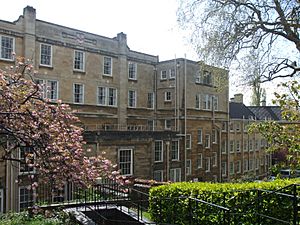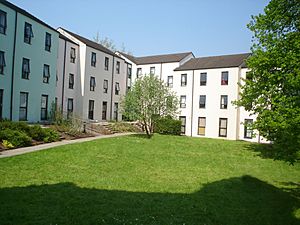Manor Hall, Bristol facts for kids
Quick facts for kids Manor Hall |
|
|---|---|
 |
|
| University | University of Bristol |
| Location | Clifton, Bristol, England |
| Coordinates | 51°27′16″N 2°36′43″W / 51.4545°N 2.6120°W |
| Motto | Estote ergo prudentes sicut serpentes et simplices sicut columbae (Latin) |
| Motto in English | Be ye as wise as serpents and as innocent as doves |
| Established | 1932 |
| Architect | Sir George Oatley |
| Status | Student hall of residence |
| Warden | Dr Martin John Crossley Evans, MBE, JP, FSA, FGS. |
| Residents | 350 |
| Map | |
Manor Hall is a place where students live while studying at the University of Bristol. It's located in Clifton, a historic part of Bristol, England. About 340 students live here, either in the main building or in smaller houses nearby. They can cook their own meals.
Most residents are first-year university students. Some students also choose to stay longer to help with hall activities. Students run many groups here. The biggest is the Junior Common Room. All undergraduate students living at Manor Hall are part of it. An elected committee plans fun social events all year.
Older students called Senior Residents help look after the younger students. Many former residents stay in touch through the Manor Hall Association. This group organizes events for both current and past students.
Contents
The Main Hall: A Historic Home
The main Manor Hall building was built between 1927 and 1932. It was first a home for women students. It stands in the gardens of Manor House, which is now another student building. The hall gets its name from Manor House.
The hall was made possible by Henry Herbert Wills. It was designed by Sir George Oatley, a famous architect. He also designed other university buildings like the Wills Memorial Building.
When the hall opened in 1932, several smaller homes for women students closed. Their residents moved into the new Manor Hall. The first leader, Mrs. Jessie D. Skemp, used to be the leader of Belgrave House.
The gardens were designed in 1934 by Hiatt Cowells Baker. Sometimes, these beautiful gardens are open for the public to visit.
The main building has a balanced design. It has rooms for about 140 students. Each floor has a single hallway with student rooms. Inside, you'll find a library, a computer room, a bar, and a common room. There's also a music room and laundry facilities. The Stops Gallery displays art by local artists.
In 2012, the hall closed for a big renovation. They updated the heating, kitchens, bathrooms, and student rooms. It reopened in September 2013, with celebrations held in June 2014.
Annexes: More Student Homes
Besides the main hall, Manor Hall includes several smaller buildings called annexes. These are located in the hall's grounds and on nearby streets. These buildings are very old, with some dating back to the 1700s.
Manor House: A Gift from the Wills Family
This annex became part of the University in 1919. It was another gift from the Wills family. Money raised from concerts by singer Dame Clara Butt helped furnish the building.
The building is near where a medieval manor house once stood. That old house was burned down in 1643 during the Storming of Bristol. The new Manor House was built in the early 1700s. It was changed and made bigger in the mid-1700s and 1800s. The terrace outside has old Roman parts, possibly brought from the Mediterranean long ago.
In the 1800s, famous scientists lived here. These included Dr. William Budd, who found out how typhoid spreads. Also, Professor John Beddoe, who studied people and wrote The Races of Man. Later, it became a school for young men. During World War I, it was used as a Red Cross Hospital.
Richmond House: An Ancient Clifton Home
Richmond House is one of the oldest houses in Clifton. It was built between 1701 and 1703. It stands where a medieval manor house once was. That old house was home to Richard Amerike. Some historians believe the continent of America was named after him. Amerike supported the explorer John Cabot, who sailed from Bristol in 1497.
This building is an English Heritage Grade II listed building. This means it's a very important historic building. In the 1790s, it was a boarding school for young gentlemen. From the 1860s to the 1940s, the Smith family lived here. One daughter, Miss Emily Harriet Smith, became one of the first women on the city council in 1920. She was also one of the first female judges.
Sinclair House: Modern Living for Students
Sinclair House was built partly where Holland Cottage stood. That cottage was destroyed during German air raids in 1940. Sinclair House opened in 1978. It is named after Lady Sinclair of Cleeve, who helped the University for many years.
The building has twelve flats, each for five students. There are also ten ground-floor flats for international postgraduate students and their families. The British Council helped fund this project. They wanted students from the Commonwealth or those with British Council Scholarships to live there.
Richmond Terrace: Refurbished Townhouses
Richmond Terrace was built in the 1780s. These were large townhouses. Numbers 30-35 Richmond Terrace used to be a hotel. The University bought it in 2006. It was fully renovated and now has modern rooms for 92 students. Each student has their own bathroom. It became part of Manor Hall in 2012.
115 Queen's Road: The Newest Annex
115 Queen's Road is the newest annex for Manor Hall. It used to be part of Clifton Hill House until 2017. It houses 42 first-year students and two Senior Residents.
Student Life: Fun and Activities
All undergraduate students living at Manor Hall are part of the Junior Common Room. A committee is chosen each year to plan many social events. These include a welcome party for new students, sports, formal dinners, and a garden party.
Manor Hall also has student clubs just for its residents. These include a Music and Drama Society, a Debating Society, and a Christian Union. There's also a Charity Committee that raises money for good causes all year.
Each year, Manor Hall has traditions like two musical or drama shows. They also have three formal dinners and a garden party to celebrate the end of the academic year.
Music and Drama Society: MAD Productions
The Manor Hall Amateur Dramatics Society, or 'MAD', started in October 1933. Their first show was a play called The Child in Flanders. Recent plays include Mostellaria, And Then There Were None, and The Crucible.
Manor Hall Association: Staying Connected
Students who have lived at Manor Hall for at least one term can join the Manor Hall Association. This group helps former residents stay in touch with each other and the hall. The Association plans the annual Summer Ball. This event celebrates the students who are graduating. In 2014, the Summer Ball also marked the hall's 80th anniversary.
The Association has a long history. It started in 1925 as the 'Elton House Old Students’ Association'. When students moved to Manor Hall in 1932, the group changed its name. It is run by volunteers. The Association was restarted in 2007 to help alumni stay connected.
Elton House Award: Recognizing Contributions
Each year, the Association gives the Elton House Award to up to two members. This award is for students who have greatly helped the Manor Hall community. It started in 2008 to celebrate the Association's return. It also honors the hard work of certain individuals. The name comes from Elton House, one of the old student hostels.
Winners get three years of free membership to the Association. They also receive a certificate and a special pin. The award is usually given during the Summer Ball.
The MHA Fund: Supporting the Hall
In 2012, the Association created a special fund. This fund helps Manor Hall and its student groups. It provides money for things that will benefit the hall and future students. Groups can apply for money from the fund. The Association raises money for the fund throughout the year, often with raffles at events.
Crest, Motto, and Tie: Symbols of Manor Hall
The hall's crest is split into two parts. The top part shows a golden sun. This sun comes from the family crest of the Wills family. The University also uses this "sun in splendour" on its own crest.
The bottom part shows a coiled snake. This comes from the crest of the Wolstenholme family. The snake is a symbol of wisdom, healing, and learning.
The hall's motto comes from a Bible verse, Matthew 10:16. It says, "Be as wise as serpents and as innocent as doves."
The hall tie is red with the golden Wills family sun. The red color is called Bristol or "Bristowe" red. The University founders chose this color for the robes of all Bristol graduates. It's said to be from a famous dye used in medieval Bristol. However, Sir Isambard Owen, a university leader, actually took the color from a band of limestone in the Avon Gorge.
Notable Alumni: Famous Former Residents
Many successful people have lived at Manor Hall. Here are a few:
- Dr. Jennifer Bate OBE, a concert organist.
- Dame Professor Carol Black DBE FRCP, a former leader of the Royal College of Physicians.
- Jemima Goldsmith, a writer and campaigner.
- Mark Ravenhill, a playwright and actor.
- David Walliams, a comedian and actor.
- Matthew Warchus, a director and dramatist.
- Emily Watson, an actress.





